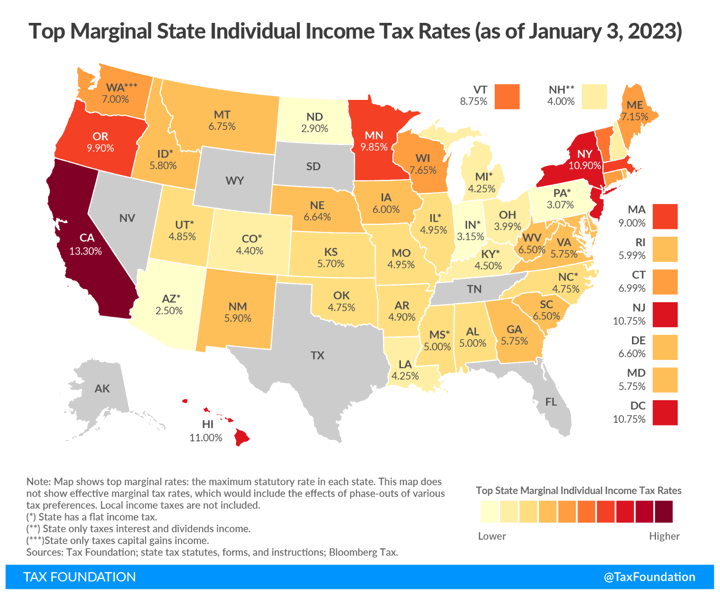Updated January 2024. As the brokerage 1099 forms for 2023 are coming out, here is a quick reminder for those in states with local income taxes. If you earned interest from a money market fund, a significant portion of this interest may have come from US Treasury bills and bonds, which are generally exempt from state and local income taxes. However, in order to claim this exemption, you’ll have to manually enter it on your tax return after digging up a few extra details.
(Note: California, Connecticut, and New York exempt dividend income only when the mutual fund has met certain minimum investments in U.S. government securities. They require that 50% of a mutual fund’s assets at each quarter-end within the tax year consist of U.S. government obligations.)
Let’s take the default cash sweep option for Vanguard brokerage accounts, the Vanguard Federal Money Market Fund (VMFXX), which has an SEC yield of 5.29% as of 1/29/24. Vanguard has recently released the U.S. government obligations income information for 2023 [pdf] for all their funds, which states:
This tax update provides information to help you properly report your state and local tax liability on ordinary income distributions you received from your mutual fund investments in 2023. On the next pages, you’ll find a list of Vanguard funds that earned a portion of their ordinary dividends from obligations of the U.S. government. Direct U.S. government obligations and certain U.S. government agency obligations are generally exempt from taxation in most states.*
To find the portion of Vanguard dividends that may be exempt from your state income tax, multiply the amount of “ordinary dividends” reported in Box 1a of your Form 1099-DIV by the percentage listed in the PDF. Note that on the IRS Form 1099-INT, there is a special Line 3 that includes “Interest on US Savings Bonds & Treasury obligations”. However, for the Vanguard funds, they report on 1099-DIV and not 1099-INT. My Vanguard 1099-INT was all zeros.
For the Vanguard Federal Money Market Fund, this percentage was 49.37% in 2023. Therefore, if you earned $1,000 in total interest from VMFXX in 2023, then $493.70 could possibly be exempt from state and local income taxes. If your marginal state income tax rate was 10% that would be a ~$50 tax savings for every $1,000 in total interest earned. This could apply to certain residents with enough income in states like Oregon, Hawaii, or Minnesota but not California, Connecticut, and New York due to their unique restrictions mentioned earlier.
However, the Vanguard Treasury Money Market Fund (VUSXX) does meet the threshold requirements for California, Connecticut, and New York as it had a GOI percentage of 80.06% in 2023. If your marginal state income tax rate was 10% that would be a ~$80 tax savings for every $1,000 in total interest earned. With a SEC yield of 5.30% as of 1/29/24, this is why many people chose to manually buy VUSXX instead of the default settlement fund as it can earn you a higher after-tax interest rate.
The following Vanguard funds and ETF equivalents have 100% of their interest from US government obligations:
- Short-Term Treasury Index Fund (VGSH, VSBSX)
- Intermediate-Term Treasury Index Fund (VGIT, VSIGX)
- Long-Term Treasury Index Fund (VGLT, VLGSX)
- Extended Duration Treasury Index Fund (EDV)
- Short-Term Inflation-Protected Securities
Index Fund (VTIP, VTAPX) - Inflation-Protected Securities Fund (VIPSX, VAIPX)
Note that several other Vanguard funds have a lower but nonzero percentage of dividends from US government obligations, including the popular Vanguard Target Retirement Income funds. It may be worth a closer look.
I don’t believe that TurboTax, H&R Block, and other tax software will do this automatically for you, as they won’t have the required information on their own. (I’m also not sure if they ask about it in their interview process.) If you use an accountant, you should also double-check to make sure they use this information. Here is some information on how to enter this into TurboTax:
- When you are entering the 1099-DIV Box 1a, 1b, and 2a – click the “My form has info in other boxes (this is uncommon)” checkbox.
- Next, click on the option “A portion of these dividends is U.S. Government interest.”
- On the next screen enter the Government interest amount. This will be subtracted from your state return.
Standard disclosure: Check with your state or local tax office or with your tax advisor to determine whether your state allows you to exclude some or all of the income you earn from mutual funds that invest in U.S. government obligations.
[Image credit – Tax Foundation]




